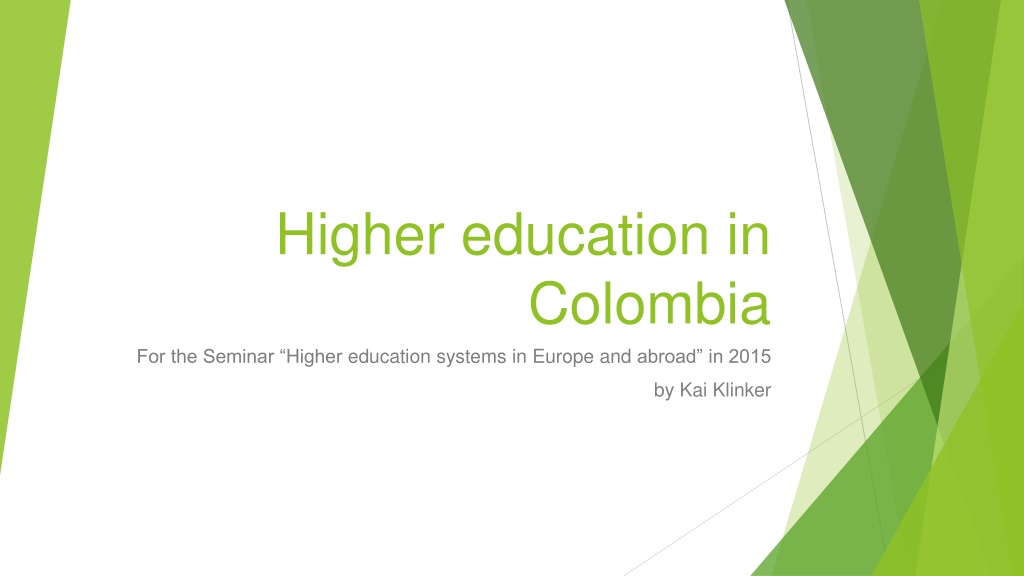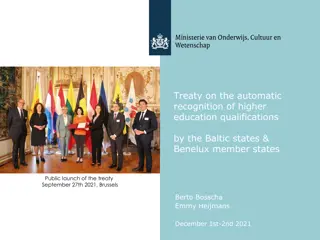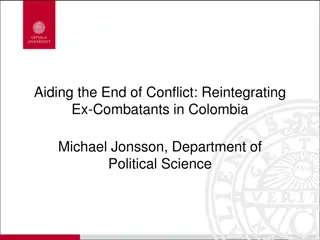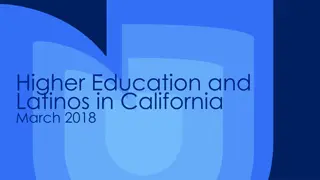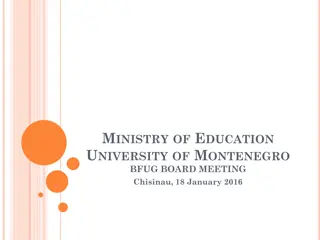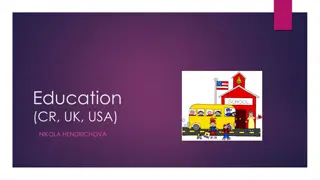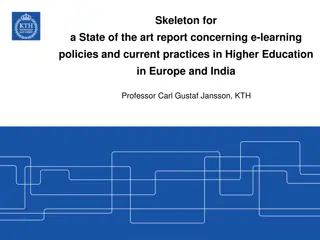Higher Education System in Colombia
Colombia, with a population of about 40 million, has a diverse landscape and rich history. The Colombian education system, including institutions like Universidad Nacional de Colombia, offers programs in various disciplines. The academic year typically consists of summer and winter semesters, with a focus on earning credits. The country has faced challenges such as armed conflict, but has shown progress and growth in recent years.
Download Presentation

Please find below an Image/Link to download the presentation.
The content on the website is provided AS IS for your information and personal use only. It may not be sold, licensed, or shared on other websites without obtaining consent from the author.If you encounter any issues during the download, it is possible that the publisher has removed the file from their server.
You are allowed to download the files provided on this website for personal or commercial use, subject to the condition that they are used lawfully. All files are the property of their respective owners.
The content on the website is provided AS IS for your information and personal use only. It may not be sold, licensed, or shared on other websites without obtaining consent from the author.
E N D
Presentation Transcript
Higher education in Colombia For the Seminar Higher education systems in Europe and abroad in 2015 by Kai Klinker
Outline General information about Colombia Geography History Colombian Education system The Universidad Nacional de Colombia (UNAL) Computer science at the UNAL Student Life
Colombia Population: About 40 Million inhabitants Territory: 1.141.748 square kilometers (Germany has 357.168) Official Language: Spanish Currency: Colombian Pesos (2745 Pesos are 1 Euro 20.1.2015) Natural resources: Oil and gas Coal Emeralds (80% of worldwide production) Nickel, gold, silver, platinum, iron ore
Climate Equator passes through the south of Colombia Does not have seasons like we do, only rain seasons The climate depends a lot on the altitude
San Andres Lies in the Caribbean sea northwest of of Colombia Average temperature: 28 degrees Celsius
Bogota Capital of Colombia About 8 million inhabitants Altitude: 2650 m Average temperature: 13 degrees Celsius
Colombian History Colonized by the Spanish in 1499 There is an ongoing armed conflict that started in the 1960s The main participating groups are: Guerilla groups (FARC and ELN) Paramilitary groups (de-mobilized in 2001) Colombian military Crime syndicates (such as the Medellin cartel) The conflict was the most violent in the 1990s and has cooled down since 2000. It is estimated that about 220 000 people were killed and that 80% of the victims were non-combatant civilians. About 6 million people have been displaced since 1985
Academic Year and Credits Academic year Summer semester: February to June (April to September in Germany) Winter semester: usually August to December (October to March in Germany) The semester can be delayed by strikes and demonstrations Credits The master lasts 4 semesters Total amount of credits: 52 => 1 Colombian credit ~ 120/52 ~ 2.3 ECTS
Teaching style Very different to studying at a German university Much more similar to school Lectures are held in classrooms Typical class size: 8-25 students The professor behaves more like a teacher
Teaching style The grades are gathered throughout the year by Homework Tests Presentations Software Projects Final projects Final exams On average there was about one mark per week
Grading Grades From 5 to 1 5 is the best mark and 1 the worst (inverse to our system) The last passing grade is 3 Formula: 1+3*(5 - colombian mark)/2 Example: A 4.0 in Colombia 1+3*(5 4.0)/2 = 2.5 So a 4.0 in Colombia would correspond to a 2.5 in Germany
Universidad Nacional de Colombia (UNAL) One of three public universities in Colombia The amount of money students have to pay per semester depends on their parents income. Is considered to be the best university in Colombia (place 316), together with the private Universidad de los Andes (place 262 in QS university worldwide rankings 2014) 50 000 students (TUM 37 000) Has campuses in 8 different cities in Colombia. 94 pre-graduate programs 148 Master programs 54 doctor programs
Computer Science at the UNAL Called Ingenieria de Sistemas y Computacion Bachelor: 5 years and a total of 165 credits 48 credits in basic subjects (Mostly math but also economics and science) 84 credits in basic computer science lectures 33 credits electives 12 credits language courses
Computer Science at the UNAL Master: 2 years and a total of 52 credits 22 credits Master s thesis 4 credits Master project 6 credits Seminars 20 credits electives
Courses I took Temas avanzados de Ingenieria de software I (advanced topics in software engineering) Project: We built a web application to play peg-solitaire in group of three people We tried to use SEMAT in the project (an agile development method like SCRUM) Optimizacion Bio-Inspirada (Bio-inspired optimization techniques) We had to implement several algorithms ourselves and apply them to test problems Topics: Genetic algorithms, Particle Swarm Optimization, Simulated annealing and ant colony optimization
Student life Many activities offered at the university For example: Climbing, soccer, dancing, martial arts, yoga, gymnastics, running, American football, chess, table tennis, weight lifting, tennis, squash, futsal, basketball, frisbee To participate you need to find the person in charge for that activity and talk to them It is easy to find friends
Colombian education System Edad Grado Nivel Institucional Preescolar 1-2 Prejard n 2-3 Jard n 3-4 Preescolar Jard n Infantil / Educaci n Preescolar 4-5 K nder 5-6 Transici n Primaria 6-7 1 7-8 2 8-9 3 Escuela Primaria / Educaci n B sica Primaria 9-10 4 10-11 5 B sica Secundaria 11-12 6 12-13 7 B sica / Educaci n B sica Secundaria 13-14 8 14-15 9 Alta Secundaria 15-16 10 16-17 11 Bachillerato / Educaci n Media 17-18 12 (S lo en algunos colegios) Educaci n Superior 18+ Universidad Universidad / Educaci n Superior
Colombian education System Total de cr ditos exigidos Cr ditos obligatorios Cr ditos optativos Agrupaci n Matem ticas, Probabilidad y Estad stica Ciencias Naturales Ciencias Econ micas y Administrativas Total 30 0 30 8 4 12 6 0 6 44 4 48
Colombian education System Total de cr ditos exigidos Agrupaci n Cr ditos obligatorios Cr ditos optativos Arquitectura y Hardware de Computadores 9 0 9 M todos y Tecnolog as de Software 24 0 24 Infraestructura de Sistemas 9 0 9 Sistemas de Informaci n y Organizaciones 6 0 6 Investigaci n de Operaciones 9 0 9 Tecnolog as de Aplicaci n 9 12 21 Sin Agrupaci n (Trabajo de Grado) 6 0 6 Total 72 12 84
